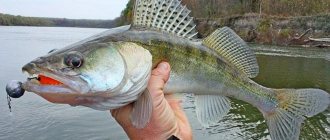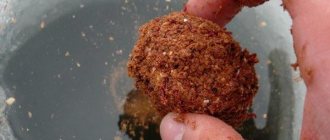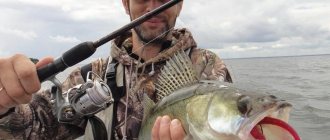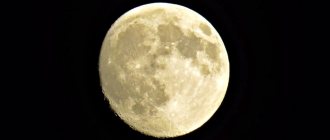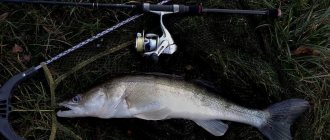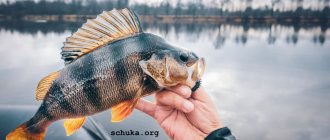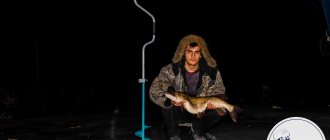Hunting for the largest representative of the perch family, pike perch, is characterized by incredible adrenaline and a lot of pleasant sensations, but here a certain skill is required from the angler to catch the nocturnal predator.
The dimensions of the trophy can reach over 1 meter, and the weight will be 20 kg. Most often, there are individuals up to 3 kg. The usual habitats of the twilight inhabitant are the bottom layers of deep reservoirs, but the pike perch comes out to feed closer to the water surface, in shallow water. You can catch it with a wobbler specially designed for such purposes.
Pike perch differs from other predators in its very narrow throat and powerful fangs, which can easily bite through wooden and foam baits. It is better to choose wobblers made of plastic. Taking into account the peculiarities of the structure of the pharynx, elongated and low baits that imitate bleak, gudgeon, chub, and dace are considered catchy for a representative of the perch family.
An important point: pike perch is a punctual fish, its actions are constantly repeated under appropriate weather conditions and time of day. In terms of fishing, this is quite convenient prey; the main thing is to notice the place and time when the predator comes out to feed.
Advantages and disadvantages
The positive qualities of the bait include:
- A huge range of models designed for different fishing conditions.
- They work great in any body of water , at different depths.
- During the fishing process, the bait realistically conveys all the movements of a wounded fish, which instantly falls into the field of view of the fished object and provokes it to capture the victim.
- Reusable use of artificial fish , which is impossible when using natural baits;
- The specific nature of the wobbler's play also contributes to the activation of the bite.
But, despite the entire list of advantages, we can also note the negative aspects of artificial fish:
- Lack of attractive play at the wrong depth.
- There are models that require complex settings, causing snags in dense vegetation.
What to look for when choosing?
- Size. When choosing the size of the bait, you should focus on the size of the expected prey: fish up to one kilogram can be caught with a 3 cm bait, if the expected weight of the prey is 4 - 8 kg, it is advisable to use an artificial fish 5 - 10 cm.
- Color. Among the catchable colors of the bait are orange, black and red. In winter, wobblers of pink, orange and silver colors give good results.
- A game. This criterion is considered especially important in choosing a working bait; the reaction of the predator will depend on its characteristics, whether it will react or not. Here it is recommended to give preference to products with an average speed of play and a believable appearance.
- The presence of noise and sound effects is mandatory.
- Form. There can be many design options, but using a teardrop-shaped and slightly flattened configuration gives a greater effect.
It is necessary to use one or another type of bait in full accordance with the specific fishing conditions:
- In fast-flowing reservoirs where there is no dense vegetation, models with a depth of 2 m are suitable.
- During the period of schooling , when pike perch hunts for fry, baits that imitate small fish work well. But at the same time, the game must be fast in order to attract the attention of the predator as much as possible.
- In reservoirs with a quiet current, products without unnecessary loading are used, immersed to a depth of 1.5 m.
- The sinking version of the wobbler is recommended for catching prey from a depth of three meters; they are lowered slowly at an angle of 20 degrees.
- The bright colors of the products are especially relevant for night hunting, while the working depth should be over 2 m.
- During the fight, wiring should be done close to the water surface, but no more than 0.5 m. To enhance the effect of a wounded fish, the bait is then raised and lowered.
- Winter fishing involves the use of special products with a unique game and light weight. Such models are characterized by smooth immersion and are devoid of sharp fluctuations that negatively affect the bite.
- The bright colors and fast action of the bait are ideal for fishing in the warmer months of the year.
Equipment
Spinning equipment designed for hunting fanged predators does not differ from the usual jigging equipment or used for fishing with spoons:
- The nozzle is tied or fastened with a carabiner to the main fishing line. If necessary, a weight – “Cheburashka” – is placed between the carabiner and the bait.
- The fluorcarbon leader is attached to the center link of the triple swivel. Leash 0.6-1.5 m. A fishing line is attached to the top one, and a leash 0.3-0.5 m with a sinker is attached to the bottom one. The bait is tied or fastened to the central leash. Fluorcarbon with a breaking load of about 7 kg is ideal as a leash.
The minimum number of fittings is the key to the sensitivity of the gear.
Spinning tackle
The requirements for a spinning rod for fishing with a wobbler differ little from a jig rod designed to work with light bait weights.
A spinning rod must be able to:
- Perform a hard sweep.
- Make a long cast with light bait, which is especially important when fishing from the shore.
- Feel the bite, preferably tactilely - in your hand. This quality is especially important when fishing at night.
Plug-in models, even the cheapest ones, have better characteristics than telescopic ones. Especially when you compare them in terms of strength.
The following spinning rod is suitable for wobbler fishing:
- Medium-fast action, 2.4 - 2.7 m, test 5-40 g - for fishing from a boat;
- Medium-fast action, 2.7 - 3 m, test 5-40 g - for coastal fishing;
- Fast action, 2.7 - 3 m, test 10-60 g - for night fishing.
For reliable hooking, the rod test should exceed the weight of the bait by 5-10 g.
Reel and line
On a spinning rod, a spinning or multiplier reel is used for wobbler fishing. The multiplier is especially good during night fishing. The coil must meet the following requirements:
- inertia-free middle class (2500-3000);
- a spool with a capacity of at least 120 m of fishing line;
- well-adjustable smooth front clutch;
- Smooth and silent operation.
For casting distance, the density and volume of winding the fishing line on the spool matters. The distance from the edge of the spool to the winding should not be more than 1-2 mm. To fill the spool, if there is a shortage of main fishing line, the lower layers may consist of an auxiliary winding that is not used during fishing.
Multiplier and inertial reels are superior to non-inertia reels only during night fishing, since they have the ability to tactile sensitivity, as well as in the case of using wobblers that create high resistance, commensurate with a load of more than 40 g.
For fishing with a wobbler, both regular fishing line and braided line with the following parameters are used:
- braid 0.14-0.24 mm;
- monofilament line with a low elongation coefficient - 0.25-0.3 mm.
Catching models
Among the variety of baits for a nocturnal predator, the most effective models are distinguished, which include:
L – minnow 44
This is a catchable product from the Japanese manufacturer Yo-Zuri from the budget series (cost 350 rubles), but with good performance characteristics: convenient for use at night, it is of the sinking type, intended for twitching and casting. The ultralight model, with a length of 3.5 cm, an immersion depth of 2 m, is equipped with one hook and weighs 5 grams.
Greedy – Guts
The model of Japanese origin (Pontoon 21) is endowed with excellent performance, dynamics and acoustic properties, and is intended for fishing at night. The product is of the floating type, used for casting and twitching, classified as suspended. The wobbler dives to a depth of 1.5 m, weighs 6 grams, length 3.5 cm, and is equipped with two hooks.
The cost of the bait is 370 rubles.
Hornet
The Polish product has gained trust among potential consumers for its functionality; it works both from a boat and from the shore, in quiet and strong currents. The model is a floating and sinking type, used for casting and trolling, ultralight, works in shallow water. Working depth is 0.5 m, the product weighs 3 g, length is 2.5 cm, equipped with two hooks (RUB 240).
TD Shiner 1062 SP (Daiwa)
The bait is capable of catching fairly large pike perch. The model works on the surface, is intended for casting and trolling, from the suspender classification. Working depth 2 m, product weighs 5.5 g, length 11 cm, equipped with two hooks (360 rubles).
Barra Magnum (Rapala)
The bait works at depths of over 5 m, is of the floating type, and is used for casting and trolling. The deep-sea wobbler weighs 20 grams, has a length of 11 cm, and is equipped with two hooks with No. 3 (410 rubles).
Hils Master (Haka)
The model attracts predators with its bright and lively game and is designed for catching prey from great depths. This is a floating type of bait, intended for casting, from the ultralight classification, weighs 4 grams, length 7 cm, equipped with one hook (370 rubles).
Rapala Shad Rap
This unique and popular model is capable of functioning in different fishing conditions, regardless of the type of wiring. The product is of the floating type, used for casting and trolling, from the classification of deep-sea baits. Working depth is 4.5 m, the product weighs 6 grams, length 6 cm, equipped with two hooks with No. 5 (450 rub.).
Trolling for pike perch with a wobbler
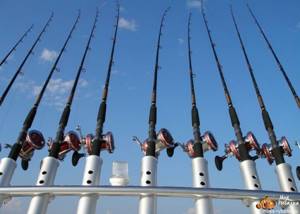
In general, fishermen are accustomed to using traditional artificial baits when trolling to catch pike perch, such as oscillating spoons or jig heads with silicone attachments, but properly selected wobblers sometimes surpass this predator in its catchability.
To begin with, we should note what are the most promising places for trolling:
- underwater hills;
- pits;
- snags;
- stone rubble;
- riffles.
To the distinctive feature of trolling for pike perch, we also note that the wiring should not be fast, the speed should not exceed about 2-5 km/h.
Wobblers for trolling
Wobblers used for boat trolling:
- Reef Runner Rip Shad 200 and Rip Shad 400 - specially released models for walleye fishing
- Lindy Shadling - features a noise system to attract pike perch, used at speeds of 1-5 km/h
- Sebile Rattsler - due to the special shape of the bow, a noise effect is created that attracts a predator, depth is from 4 to 6 meters.
- Cotton Cordell Wally Diver is recognized as one of the best options for trolling wobblers as it has several types of depth, which allows it to be used in various conditions. Dimensions 62.5mm and 94mm, depth 6m.
- Rapala Barra Magnum - this artificial bait is universal and is used to catch not only pike perch, but also catfish, and is in the top popularity among professional fishermen.
High-quality and effective fishing with a spinning wobbler for catching pike perch also depends on correctly selected equipment.
Fishing tackle
To get a good catch it is recommended to use:
- High quality spinning rod. The tool must have a hard and sensitive tip, a length of 2 m and a test load of 40 g. The best option is a fiberglass fishing rod.
- As a good reel, choose inertia-free models equipped with a brake clutch and a baitrunner (spool 2500 - 3000).
- Considering the powerful resistance of pike perch when fishing , it is recommended to use a strong fishing thread, in particular nylon fishing line with a cross-section of 0.40 mm.
- Hooks No. 3 – 5 are perfect for catching predators.
- A stand will come in handy here. As an option, you can choose a genus-under device.
Successful models of deep-sea pike-perch wobblers
Among the wide variety of deep-sea wobblers, the following models can be noted that work reliably when catching pike perch:
– Yo-Zuri 3D Crank; – Rapala Deep Tail Dancer; – Akara Deep Robber; – Bomber Deep LongA; – Deep Minnow C 100; – Megabass Deep X-300. – Strike Pro Crankee Runner;
For catching pike perch, it is most advisable to use floating models of deep-sea cranks, since they pass water obstacles more easily and allow you to fish with stop&go fishing .
Popular on the topic : 5 best trolling wobblers
Pike-perch tackle
To catch pike perch with deep-sea wobblers, the issue of choosing gear must be approached carefully. This is due to the fact that deep wobblers, due to the presence of a large blade, create a very large load on the tackle, especially on the reels. Therefore, it is desirable that the tackle for catching pike perch be powerful.
You can take a cord that is not very thick, which will allow you to make long casts and quickly drive the crank to the working horizon of the retrieve. This is especially true if fishing is carried out on rivers where potentially promising places are located close to the axis of the river flow.
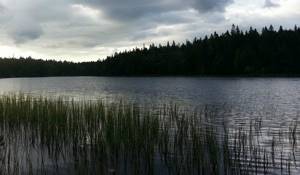
Time and place
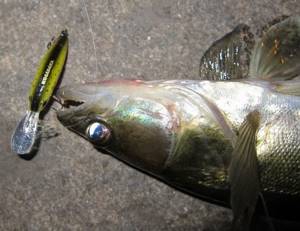
The right place to catch night pike perch is the key to successful fishing.
Particular attention should be paid to:
- reservoir areas with large deep-water holes;
- to places with a sharp transition in depth;
- areas with current;
- areas near steep banks, cliffs;
- pits, ditches;
- clay and muddy bottom;
- in shallow water;
At sunset, the predator can be found on shallow edges, far from the coastline ; it is also necessary to examine the stone ridges on the rivers behind the rifts.
The pike perch enters shallow water after midnight and hunts for prey until dawn. From dawn to 9 am you need to fish classic pike perch places, in particular deep edges and pre-channel areas. During the day you can observe only one-time bites in various parts of the reservoir.
From 18.00 to 22.00, edges and slopes remain promising places.
Selecting a location
The fanged predator prefers to live in places with clean water and a difference in depth. The general rule is that a wobbler, without additional loading, is used in smaller places than a jig:
- Big river – shallows up to 2-3 m, edges and exits from pits. Dams and flooded dams, snags on wide reaches, and deep drops from sand spits are attractive.
- A river of medium order - high cliffs at turns with a hard bottom, reverse currents, holes and edges, snags in the shade of trees or stones behind which you can set up an ambush, shallow waters above and below riffles, shallows near bridge piles.
- Reservoirs and flowing lakes are the most attractive exits from flooded river beds, “tables” at a depth of up to 3 m, exits from deep-sea pits, as well as exits from flooded deep-sea snags. At night, stretches and “tables” with a depth of 2-3 m can be interesting.
- In all bodies of water there is such a phenomenon as a “pike-perch fight”, when pike-perch, united in a flock, squeeze a school of bleak or other fish onto the surface of the water. In such a place, a small wobbler thrown at the right time can work wonders.
- During night fishing, the most effective are exits from holes, edges, riffles and shallow waters.
The habitat habits of fish need to be constantly studied. Without the process of studying a specific body of water, successful fishing is impossible.
How to catch?
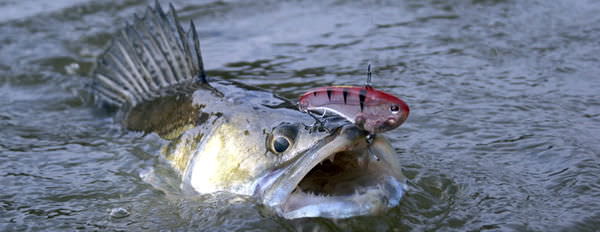
Having decided on the place and time of fishing, a cast is made: the tackle is adjusted, brought into working position, the wobbler is strung on the hook, the sting is masked and the bait is cast to the selected depth.
It is recommended to perform the posting at a slow speed so that the pike perch does not suspect anything. There is an opinion that it is more convenient to hold a wobbler while sitting, but this is a personal matter for everyone. In the process, one hand closes the bow, and the other turns the handle on the reel. Then you can start reeling the bait towards you.
To additionally attract prey, it is advisable to take short breaks.
To avoid difficulties when fishing, you should not make sudden movements, it is better to make one more turn with the reel, the hook will be 100%.
If there is no bite for a long time, the artificial fish must be brought closer to the watercraft, or to the coastline , and tilt the tip of the rod into the water. Often, the predator leads the bait 10 m, as a result of which the bite can occur directly near the shore.
The hook is done confidently and strongly, otherwise the predator will have time to recover and begin to fight. It is extremely rare for a pike perch to come off the hook; its lips are too strong. The use of a landing net in this case is completely justified.
Deep-sea wobblers of the deep class
Deep-sea wobblers are baits of the so-called deep class, which can be used for fishing at significant depths. Some models of deep wobblers are capable of diving to a depth of ten meters. Speaking about deep-sea wobblers for pike perch, in 90% of cases it means the use of cranks , which are most effective when catching fanged ones. But, in some situations, pike perch prefers deep-sea minnows or is even ready to tear rattlins to shreds.
Almost all deep-sea cranks have a narrow body that resembles a drop. This is due to the fact that a wide-bodied bait is more difficult to drive to greater depths and will need to be equipped with a larger blade, which will increase the resistance of the wobbler when retrieving and reduce the flight range when casting due to the larger windage of the bait.
When choosing a deep crank for catching pike perch, you should also imagine in advance how this or that wobbler model will behave on the retrieve. Pot-bellied cranks with wide blades have a large amplitude of vibration, and more powerful cranks have a high frequency of vibration, but they are not so “noisy”.
Fishing Features
At night time
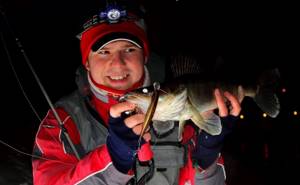
- Night fishing for pike perch will be most effective in shallow water.
- The best catching models for perch fish are considered to be bait from the minou class, the size of which is 5 – 7 cm.
- For night hunting, it is recommended to use brightly colored products.
- The working depth of the wobbler for pike perch should be 1.5 m, and the game should be fast and interesting.
- Wiring at night is smooth and moderate.
- Biting prey is similar to hooking, so there is no need to wait for sharp and strong shocks.
- most active in September, when the water temperature drops and becomes cooler.
- Night hunting begins at nightfall.
- As a reliable fishing thread, it is recommended to use a fluorocarbon version of the fishing line with a load of up to 4 kg.
Depending on the season
- In winter, hunting for pike perch can please you with a catch only in studied water areas. It is advisable to choose deep-sea locations for drilling holes. The fisherman’s winter equipment should not restrict his movements, but at the same time reliably protect him from frost. The best clothing option is a thermal suit. A fisherman can expect a good catch on the first ice and during periods of sudden warming.
- In the fall, hunting a predator is a pleasure: the fish actively feeds, stores for the winter, and takes any bait. It is better to fish from a boat, using 2.5 m spinning tackle and a test load of over 40 grams.
- In summer, pike perch tries to hide in the shade under overhanging trees. To attract his attention, choose active baits with sound and sound effects.
- In the spring, it is recommended to go hunting with large wobblers and experiment with flavors. The season begins in March, the predator still lives at depth, so it is necessary to use deep-sea products with a depth of up to 4 m.
Frequency of biting depending on the time of year
The periods of activity of the “fanged one” alternate in accordance with life cycles, which in turn are closely related to the time of year:
- The beginning of spring pike perch fishing coincides with the period when open water appears. Water warms up fastest at the mouths of opened rivers and in shallow waters of 1-2 meters. It is here that small fish move, and behind them a predator comes out to feed in the shallows. Activation of the spring bite is observed during the flood period and lasts 1-1.5 weeks. The bite ends with the beginning of spawning. In different regions, spawning occurs from April to early June.
- Summer zhor comes 1-2 weeks after the fish leave the spawning grounds. July and August live up to the nickname “twilight predator”, during which time the fish switches to twilight and nocturnal feeding. The bite becomes active during the hours when the sun sets and rises, as well as in the first hours of darkness. In some reservoirs the bite continues all night.
- The best time for jigging pike perch in the fall comes with cold nights in mid-September - early October. The autumn bite alternates with moments of hunger. At this time, the predator moves to deep winter holes and becomes accessible only from a boat using a wobbler with a weight of up to 40 g. The bite in open water continues until freeze-up.
